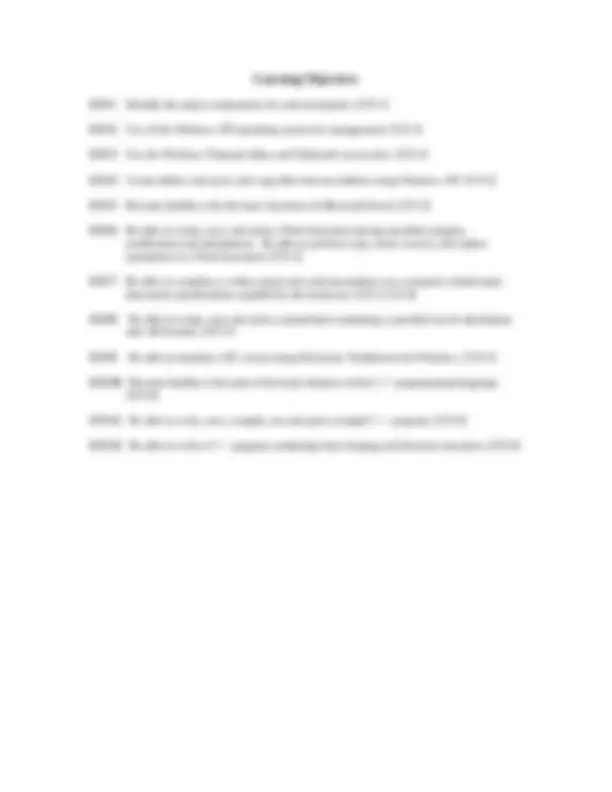



Study with the several resources on Docsity

Earn points by helping other students or get them with a premium plan


Prepare for your exams
Study with the several resources on Docsity

Earn points to download
Earn points by helping other students or get them with a premium plan
Community
Ask the community for help and clear up your study doubts
Discover the best universities in your country according to Docsity users
Free resources
Download our free guides on studying techniques, anxiety management strategies, and thesis advice from Docsity tutors
The program outcomes, course outcomes, and learning objectives for a course in microcomputer applications for technicians. Students will learn to author technical reports, deliver oral presentations, and gain a working knowledge of the windows operating system, c++ programming language, and various application programs. Assessments include graded lab assignments, oral presentations, and the exit exam.
Typology: Study notes
1 / 2

This page cannot be seen from the preview
Don't miss anything!


PO-1. The ability to author quality technical reports that follow the guidelines established by the program. Assessment is made through graded laboratory assignments. PO-2. The ability to deliver oral presentations that follow the guidelines established by the program. Assessment is made through graded oral presentations. PO-3. A working knowledge of the Windows operating system and application programs; including Word, Excel, Electronic Workbench, and Visio. Assessment is made through the appropriate sections of the Exit Exam and through graded laboratory assignments laboratory assignments, laboratory reports, homework, and tests. PO-5. A working knowledge of the C++ programming language including software troubleshooting. Assessment is made through the appropriate sections of the Exit Exam.
CO-1 Study the components of a microcomputer and obtain an understanding of how the operating system manages its resources. [PO-3] CO-2 Obtain an understanding of the basic features of the Windows XP operating system environment. [PO-3] CO-3 Prepare a written formal report. [PO-1] CO-4 Present an oral report. [PO-2] CO-5 Obtain an understanding of microcomputer application programs including Microsoft Word, Microsoft Excel, Electronic Workbench, and Visio. [PO-3] CO-6 Study the fundamentals required to develop a program in the C++ language. [PO-5]
LO-1 Identify the major components of a microcomputer. [CO-1] LO-2 Use of the Windows XP operating system for management. [CO-2] LO-3 Use the Windows Notepad editor and Clipboard accessories. [CO-2] LO-4 Create folders and move and copy files between folders using Windows XP. [CO-2] LO-5 Become familiar with the basic functions of Microsoft Excel. [CO-5] LO-6 Be able to create, save, and print a Word document having specified margins, justification and indentations. Be able to perform copy, move, search, and replace operations in a Word document. [CO-5] LO-7 Be able to complete a written report and oral presentation on a computer-related topic that meets specifications supplied by the instructor. [CO-3, CO-4] LO-8 Be able to create, save and print a spreadsheet containing a specified set of calculations and cell formats. [CO-5] LO-9 Be able to simulate a DC circuit using Electronic Workbench for Windows. [CO-5] LO-10 Become familiar with some of the basic features of the C++ programming language. [CO-6] LO-11 Be able to write, save, compile, run and print a simple C++ program. [CO-6] LO-12 Be able to write a C++ program containing basic looping and decision structures. [CO-6]